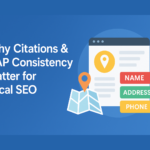- September 2, 2025
- Categories: SEO
- Tags:
Why User Experience (UX) Matters for SEO
Search Engine Optimization (SEO) has evolved far beyond keywords and backlinks. Today, Google and other search engines emphasize how real users interact with websites. This is where User Experience (UX) becomes a critical ranking factor. A website that loads quickly, is easy to navigate, and provides valuable content not only improves user satisfaction but also signals to search engines that it deserves better rankings.
In this blog, we’ll explore why UX matters for SEO, key UX factors that influence rankings, and best practices you can implement to optimize both.
What is User Experience (UX)?
User Experience refers to the overall interaction a visitor has with your website. It includes usability, design, content structure, speed, accessibility, and how easily a user can accomplish their goals.
For example, if someone lands on your site and can’t find what they’re looking for in a few seconds, they’ll leave—this increases bounce rate, which can hurt your SEO.
How UX Impacts SEO Rankings?
1. Core Web Vitals
Google introduced Core Web Vitals as a ranking signal. These metrics focus on page speed, responsiveness, and visual stability. If your site loads slowly or shifts content as it loads, users get frustrated, and Google takes note.
2. Bounce Rate and Dwell Time
If visitors leave your site immediately (high bounce rate), it signals poor UX. On the other hand, if they spend time engaging with your content (long dwell time), search engines assume your page is valuable.
3. Mobile Friendliness
With mobile-first indexing, Google primarily looks at the mobile version of your site. A clunky, hard-to-navigate mobile site means poor rankings and lost traffic.
4. Navigation and Site Structure
Good UX means users can find information quickly. A clear site structure with easy-to-follow menus improves crawlability for search engines and helps users stay longer.
5. Content Readability
Readable content (simple language, proper formatting, headers, and visuals) improves engagement. Users are more likely to scroll, click, and interact with pages that are easy to consume.
Best Practices to Improve UX for SEO
1. Improve Page Speed
- Use image compression tools (WebP format)
- Enable browser caching
- Minify CSS, JavaScript, and HTML
- Use a reliable hosting service
2. Make Your Website Mobile-Friendly
- Use responsive design
- Test mobile usability in Google Search Console
- Optimize button sizes for mobile clicks
3. Optimize Navigation
- Use a clear and consistent menu structure
- Add a search bar for large sites
- Implement breadcrumbs for better UX and SEO
4. Focus on Content Layout
- Use short paragraphs and bullet points
- Add visuals like images, infographics, and videos
- Highlight important information with subheadings (H2, H3)
5. Build Trust with Design
- Use professional, clean layouts
- Ensure consistent branding and typography
- Avoid excessive pop-ups or intrusive ads
6. Ensure Accessibility
- Add alt text to images
- Use proper color contrast for readability
- Make your site usable with screen readers
How UX and SEO Work Together?
While SEO brings users to your site, UX ensures they stay. A balance between the two creates a cycle of success:
- Good UX = Higher engagement
- Higher engagement = Better SEO signals
- Better SEO = More organic traffic
This synergy can dramatically improve rankings and conversion rates.
Common UX Mistakes That Hurt SEO
- Slow-loading websites
- Non-responsive designs on mobile
- Overuse of pop-ups and ads
- Confusing navigation menus
- Thin or duplicate content
User Experience (UX) is no longer optional—it’s at the heart of SEO success. Search engines prioritize websites that deliver value to users, and poor UX can hold your site back even if you have strong keywords and backlinks.
By focusing on speed, mobile optimization, content readability, and accessibility, you not only improve SEO rankings but also create a positive experience that keeps users coming back.




